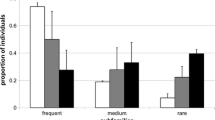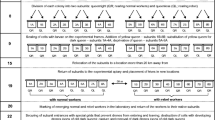Summary
Apis mellifera workers are able to discriminate the degree of relatedness to themselves of larvae and to preferentially rear queens from related larvae. They employ cues of genetic, not environmental origin, and workers which have only experienced unrelated brood nonetheless prefer related (but novel) over unrelated (but familiar) larvae. Thus worker bees possess the sensory capabilities and behavioral responses that would enable them to maximize their individual inclusive fitness through nepotism in queen rearing.
Similar content being viewed by others
References
Adams J, Rothman ED, Kerr WE, Paulino ZL (1977) Estimation of the number of sex alleles and queen matings from diploid male frequencies in a population of Apis mellifera. Genetics 86:583–596
Breed MD, Velthuis HHW, Robinson GE (1985) Do worker honey bees discriminate among unrelated and related larval phenotypes? Ann Entomol Soc Am 77:737–739
Contel EPB, Mestriner MA, Martins E (1977) Genetic control and developmental expression of malate dehydrogenase in Apis mellifera. Biochem Genet 15:859–876
Getz WM, Brückner D, Parisian TR (1982) Kin structure and swarming behavior of the honey bee Apis mellifera. Behav Ecol Sociobiol 10:265–270
Getz WM, Smith KB (1983) Genetic kin recognition: honey bees discriminate between full and half sisters. Nature [Lond] 302:147–148
Hamilton WD (1964) The genetical evolution of social behavior. J Theoret Biol 7:1–52
Harbo JR, Szabo TI (1984) A comparison of instrumentally inseminated and naturally mated queens. J Apic Res 23:31–36
Hölldobler B, Michener CD (1980) Mechanisms of identification and discrimination in social Hymenoptera. In: Markl H (ed) Evolution of social behavior: Hypotheses and empirical tests. Verlag Chemie, Weinheim, FRG, pp 35–58
Holmes WG, Sherman PW (1982) The ontogeny of kin recognition in two species of ground squirrels. Am Zool 22:491–517
Holmes WG, Sherman PW (1983) Kin recognition in animals. Am Sci 71:46–55
Laidlaw HH (1979) Contemporary queen rearing. Dadant and Sons, Hamilton, Illinois
Laidlaw HH, Page RE (1984) Polyandry in honey bees (Apis mellifera L.): Sperm utilization and intracolony genetic relationships. Genetics 108:985–997
Lehninger AL (1975) Biochemistry. Worth, New York
Martins E, Mestriner MA, Contel EPB (1977) Alcohol dehydrogenase polymorphisms in Apis mellifera. Biochem Genet 15:357–366
Masson C, Arnold G (1984) Ontogeny, maturation, and plasticity of the olfactory system in the workerbee, J Insect Physiol 30:7–14
Mestriner MA, Contel EPB (1972) The P-3 and EST loci in the honeybee Apis mellifera. Genetics 72:733–738
Page RE Jr, Erickson EJ Jr (1984) Selective rearing of queens by worker honey bees: kin or nestmate recognition. Ann Entomol Soc Am 77:578–580
Page RE Jr, Metcalf RA (1982) Multiple mating, sperm utilization, and social evolution. Am Nat 119:263–281
Pamilo P, Crozier RH (1982) Measuring genetic relatedness in natural populations: methodology. Theor Popul Biol 21:171–193
Sheppard WS, Berlocher SH (1984) Enzyme polymorphisms in Apis mellifera from Norway. J Apic Res 23:64–69
Sherman PW, Holmes WG (1985) Kinship recognition: issues and evidence. In: Hölldobler B, Lindauer M (eds) Experimental behavioral ecology and sociobiology. Sinauer Associates, Sunderland, Massachusetts, pp 437–460
Snedecor GW, Cochran WG (1967) Statistical Methods. Iowa State University Press, Ames Iowa, p 213
Taber S III (1955) Sperm distribution in the spermathecae of multiple-mated queen honey bees. J Econ Entomol 48:522–525
Taber S III (1961) Forceps designed for transferring honey bee eggs. J Econ Entomol 54:247–250
Taber S III, Wendel J (1958) Concerning the number of times queen bees mate. J Econ Entomol 51:786–789
Visscher PK (1985) Genetic structure and kinship discrimination in honey bee (Apis mellifera L.) colonies. PhD Thesis Cornell University, Ithaca, NY
Woyke J (1962) The hatchability of “lethal” eggs in a two sex allele fraternity of honeybees. J Apic Res 1:6–13
Woyke J (1969) A method of rearing diploid drones in a honeybee colony. J Apic Res 8:65–74
Author information
Authors and Affiliations
Rights and permissions
About this article
Cite this article
Kirk Visscher, P. Kinship discrimination in queen rearing by honey bees (Apis mellifera). Behav Ecol Sociobiol 18, 453–460 (1986). https://doi.org/10.1007/BF00300521
Received:
Accepted:
Issue Date:
DOI: https://doi.org/10.1007/BF00300521




